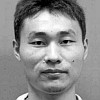| |
 
Daniel H. Huson and
Celine Scornavacca. Dendroscope 3: An Interactive Tool for Rooted Phylogenetic Trees and Networks. In Systematic Biology, Vol. 61(6):1061-1067, 2012.
Keywords: from rooted trees, from triplets, phylogenetic network, phylogeny, Program Dendroscope, reconstruction, software, visualization.
Toggle abstract
"Dendroscope 3 is a new program for working with rooted phylogenetic trees and networks. It provides a number of methods for drawing and comparing rooted phylogenetic networks, and for computing them from rooted trees. The program can be used interactively or in command-line mode. The program is written in Java, use of the software is free, and installers for all 3 major operating systems can be downloaded from www.dendroscope.org. [Phylogenetic trees; phylogenetic networks; software.] © 2012 The Author(s)."
|
|
| |

Stephen J. Willson. CSD Homomorphisms Between Phylogenetic Networks. In TCBB, Vol. 9(4), 2012.
Keywords: explicit network, from network, from quartets, phylogenetic network.
Note: http://www.public.iastate.edu/~swillson/Relationships11IEEE.pdf, preliminary version entitled Relationships Among Phylogenetic Networks.
Toggle abstract
"Since Darwin, species trees have been used as a simplified description of the relationships which summarize the complicated network N of reality. Recent evidence of hybridization and lateral gene transfer, however, suggest that there are situations where trees are inadequate. Consequently it is important to determine properties that characterize networks closely related to N and possibly more complicated than trees but lacking the full complexity of N. A connected surjective digraph map (CSD) is a map f from one network N to another network M such that every arc is either collapsed to a single vertex or is taken to an arc, such that f is surjective, and such that the inverse image of a vertex is always connected. CSD maps are shown to behave well under composition. It is proved that if there is a CSD map from N to M, then there is a way to lift an undirected version of M into N, often with added resolution. A CSD map from N to M puts strong constraints on N. In general, it may be useful to study classes of networks such that, for any N, there exists a CSD map from N to some standard member of that class. © 2012 IEEE."
|
|
| |
  
Steven Kelk,
Celine Scornavacca and
Leo van Iersel. On the elusiveness of clusters. In TCBB, Vol. 9(2):517-534, 2012.
Keywords: explicit network, from clusters, from rooted trees, from triplets, level k phylogenetic network, phylogenetic network, phylogeny, Program Clustistic, reconstruction, software.
Note: http://arxiv.org/abs/1103.1834.
|
|
| |
  
Andreas Spillner,
Binh T. Nguyen and
Vincent Moulton. Constructing and Drawing Regular Planar Split Networks. In TCBB, Vol. 9(2):395-407, 2012.
Keywords: abstract network, from splits, phylogenetic network, phylogeny, reconstruction, visualization.
Note: slides and presentation available at http://www.newton.ac.uk/programmes/PLG/seminars/062111501.html.
Toggle abstract
"Split networks are commonly used to visualize collections of bipartitions, also called splits, of a finite set. Such collections arise, for example, in evolutionary studies. Split networks can be viewed as a generalization of phylogenetic trees and may be generated using the SplitsTree package. Recently, the NeighborNet method for generating split networks has become rather popular, in part because it is guaranteed to always generate a circular split system, which can always be displayed by a planar split network. Even so, labels must be placed on the "outside" of the network, which might be problematic in some applications. To help circumvent this problem, it can be helpful to consider so-called flat split systems, which can be displayed by planar split networks where labels are allowed on the inside of the network too. Here, we present a new algorithm that is guaranteed to compute a minimal planar split network displaying a flat split system in polynomial time, provided the split system is given in a certain format. We will also briefly discuss two heuristics that could be useful for analyzing phylogeographic data and that allow the computation of flat split systems in this format in polynomial time. © 2006 IEEE."
|
|
| |
 
Paul Phipps and
Sergey Bereg. Optimizing Phylogenetic Networks for Circular Split Systems. In TCBB, Vol. 9(2):535-547, 2012.
Keywords: abstract network, from distances, from splits, phylogenetic network, phylogeny, Program PhippsNetwork, reconstruction, software.
Toggle abstract
"We address the problem of realizing a given distance matrix by a planar phylogenetic network with a minimum number of faces. With the help of the popular software SplitsTree4, we start by approximating the distance matrix with a distance metric that is a linear combination of circular splits. The main results of this paper are the necessary and sufficient conditions for the existence of a network with a single face. We show how such a network can be constructed, and we present a heuristic for constructing a network with few faces using the first algorithm as the base case. Experimental results on biological data show that this heuristic algorithm can produce phylogenetic networks with far fewer faces than the ones computed by SplitsTree4, without affecting the approximation of the distance matrix. © 2012 IEEE."
|
|
| |
 
Zhi-Zhong Chen and
Lusheng Wang. Algorithms for Reticulate Networks of Multiple Phylogenetic Trees. In TCBB, Vol. 9(2):372-384, 2012.
Keywords: explicit network, from rooted trees, minimum number, phylogenetic network, phylogeny, Program CMPT, Program MaafB, reconstruction, software.
Note: http://rnc.r.dendai.ac.jp/~chen/papers/rMaaf.pdf.
Toggle abstract
"A reticulate network N of multiple phylogenetic trees may have nodes with two or more parents (called reticulation nodes). There are two ways to define the reticulation number of N. One way is to define it as the number of reticulation nodes in N in this case, a reticulate network with the smallest reticulation number is called an optimal type-I reticulate network of the trees. The better way is to define it as the total number of parents of reticulation nodes in N minus the number of reticulation nodes in N ; in this case, a reticulate network with the smallest reticulation number is called an optimal type-II reticulate network of the trees. In this paper, we first present a fast fixed-parameter algorithm for constructing one or all optimal type-I reticulate networks of multiple phylogenetic trees. We then use the algorithm together with other ideas to obtain an algorithm for estimating a lower bound on the reticulation number of an optimal type-II reticulate network of the input trees. To our knowledge, these are the first fixed-parameter algorithms for the problems. We have implemented the algorithms in ANSI C, obtaining programs CMPT and MaafB. Our experimental data show that CMPT can construct optimal type-I reticulate networks rapidly and MaafB can compute better lower bounds for optimal type-II reticulate networks within shorter time than the previously best program PIRN designed by Wu. © 2006 IEEE."
|
|
| |
  
Zhi-Zhong Chen,
Fei Deng and
Lusheng Wang. Simultaneous Identification of Duplications, Losses, and Lateral Gene Transfers. In TCBB, Vol. 9(5):1515-1528, 2012.
Keywords: duplication, explicit network, FPT, from rooted trees, from species tree, lateral gene transfer, loss, phylogenetic network, phylogeny, reconstruction.
Note: http://www.cs.cityu.edu.hk/~lwang/research/tcbb2012c.pdf.
Toggle abstract
"We give a fixed-parameter algorithm for the problem of enumerating all minimum-cost LCA-reconciliations involving gene duplications, gene losses, and lateral gene transfers (LGTs) for a given species tree S and a given gene tree G. Our algorithm can work for the weighted version of the problem, where the costs of a gene duplication, a gene loss, and an LGT are left to the user's discretion. The algorithm runs in O(m+3 k/c n) time, where m is the number of vertices in S, n is the number of vertices in G, c is the smaller between a gene duplication cost and an LGT cost, and k is the minimum cost of an LCA-reconciliation between S and G. The time complexity is indeed better if the cost of a gene loss is greater than 0. In particular, when the cost of a gene loss is at least 0.614c, the running time of the algorithm is O(m+2.78 k/cn). © 2004-2012 IEEE."
|
|
| |
|
| |
|
| |
|
| |
|
| |
|
| |
|
| |
|
| |

Alethea Rea. Statistical approaches to phylogenetic networks, recombination and testing of incongruence. PhD thesis, The University of Auckland, New Zealand, 2011.
Keywords: abstract network, AIC, BIC, phylogenetic network, phylogeny, split, split network, statistical model.
Note: https://researchspace.auckland.ac.nz/handle/2292/67624.
|
|
| |
|
| |
|
| |
|
| |
   
Louxin Zhang,
Yen Kaow Ng,
Taoyang Wu and
Yu Zheng. Network model and efficient method for detecting relative duplications or horizontal gene transfers. In ICCABS11, Pages 214-219, 2011.
Keywords: dynamic programming, explicit network, from network, from rooted trees, from species tree, phylogenetic network, phylogeny, polynomial, reconstruction.
Toggle abstract
"Background: Horizontal gene transfer and gene duplication are two significant forces behind genome evolution. As more and more well-supported examples of HGTs are being revealed, there is a growing awareness that HGT is more widespread than previously thought, occurring often not only within bacteria, but also between species remotely related such as bacteria and plants or plants and animals. Although a substantial number of genomic sequences are known, HGT inference remains challenging. Parsimony-based inferences of HGT events are typically NP-hard under the framework of gene tree and species tree comparison; it is even more timeconsuming if the maximum likelihood approach is used. The fact that gene tree and species tree incongruence can be further confounded by gene duplication and gene loss events motivates us to incorporate considerations for these events into our inference of HGT events. Similarly, it will be beneficial if known HGT events are considered in the inference of gene duplications and gene losses. © 2011 IEEE."
|
|
| |
 
Celine Scornavacca,
Franziska Zickmann and
Daniel H. Huson. Tanglegrams for Rooted Phylogenetic Trees and Networks. In ISMB11, Vol. 27(13):i248-i256 of BIO, 2011.
Keywords: from network, heuristic, integer linear programming, phylogenetic network, phylogeny, Program Dendroscope, tanglegram, visualization.
Note: http://dx.doi.org/10.1093/bioinformatics/btr210.
Toggle abstract
"Motivation: In systematic biology, one is often faced with the task of comparing different phylogenetic trees, in particular in multi-gene analysis or cospeciation studies. One approach is to use a tanglegram in which two rooted phylogenetic trees are drawn opposite each other, using auxiliary lines to connect matching taxa. There is an increasing interest in using rooted phylogenetic networks to represent evolutionary history, so as to explicitly represent reticulate events, such as horizontal gene transfer, hybridization or reassortment. Thus, the question arises how to define and compute a tanglegram for such networks. Results: In this article, we present the first formal definition of a tanglegram for rooted phylogenetic networks and present a heuristic approach for computing one, called the NN-tanglegram method. We compare the performance of our method with existing tree tanglegram algorithms and also show a typical application to real biological datasets. For maximum usability, the algorithm does not require that the trees or networks are bifurcating or bicombining, or that they are on identical taxon sets. © The Author(s) 2011. Published by Oxford University Press."
|
|
| |
 
Changiz Eslahchi and
Reza Hassanzadeh. New Algorithm for Constructing Supernetworks from Partial Trees. In MCCMB11, Pages 106-107, 2011.
Keywords: abstract network, from unrooted trees, heuristic, phylogenetic network, phylogeny, Program SNSA, reconstruction, simulated annealing, split network.
Note: http://mccmb.belozersky.msu.ru/2011/mccmb11.pdf#page=106.
|
|
| |
    
Jean-Philippe Doyon,
Celine Scornavacca,
Konstantin Yu Gorbunov,
Gergely J. Szöllösi,
Vincent Ranwez and
Vincent Berry. An efficient algorithm for gene/species trees parsimonious reconciliation with losses, duplications, and transfers. In Proceedings of the Eighth RECOMB Comparative Genomics Satellite Workshop (RECOMB-CG'10), Vol. 6398:93-108 of LNCS, springer, 2011.
Keywords: branch length, duplication, dynamic programming, explicit network, from multilabeled tree, from species tree, from unrooted trees, lateral gene transfer, loss, phylogenetic network, phylogeny, polynomial, Program Mowgli, reconstruction.
Note: http://www.lirmm.fr/~vberry/Publis/MPR-DoyonEtAl.pdf, software available at http://www.atgc-montpellier.fr/MPR/.
Toggle abstract
"Tree reconciliation methods aim at estimating the evolutionary events that cause discrepancy between gene trees and species trees. We provide a discrete computational model that considers duplications, transfers and losses of genes. The model yields a fast and exact algorithm to infer time consistent and most parsimonious reconciliations. Then we study the conditions under which parsimony is able to accurately infer such events. Overall, it performs well even under realistic rates, transfers being in general less accurately recovered than duplications. An implementation is freely available at http://www.atgc- montpellier.fr/MPR. © 2010 Springer-Verlag."
|
|
| |
  
Mukul S. Bansal,
J. Peter Gogarten and
Ron Shamir. Detecting Highways of Horizontal Gene Transfer. In Proceedings of the Eighth RECOMB Comparative Genomics Satellite Workshop (RECOMB-CG'10), Vol. 6398:109-120 of LNCS, springer, 2011.
Keywords: explicit network, from rooted trees, from species tree, lateral gene transfer, phylogenetic network, phylogeny, polynomial, reconstruction.
Note: http://www.cs.iastate.edu/~bansal/Highways_RCG10.pdf.
Toggle abstract
"In a horizontal gene transfer (HGT) event a gene is transferred between two species that do not share an ancestor-descendant relationship. Typically, no more than a few genes are horizontally transferred between any two species. However, several studies identified pairs of species between which many different genes were horizontally transferred. Such a pair is said to be linked by a highway of gene sharing. We present a method for inferring such highways. Our method is based on the fact that the evolutionary histories of horizontally transferred genes disagree with the corresponding species phylogeny. Specifically, given a set of gene trees and a trusted rooted species tree, each gene tree is first decomposed into its constituent quartet trees and the quartets that are inconsistent with the species tree are identified. Our method finds a pair of species such that a highway between them explains the largest (normalized) fraction of inconsistent quartets. For a problem on n species, our method requires O(n 4) time, which is optimal with respect to the quartets input size. An application of our method to a dataset of 1128 genes from 11 cyanobacterial species, as well as to simulated datasets, illustrates the efficacy of our method. © 2010 Springer-Verlag."
|
|
| |
  
Shlomo Moran,
Sagi Snir and
Wing-Kin Sung. Partial Convex Recolorings of Trees and Galled Networks: Tight Upper and Lower bounds. In ACM Transactions on Algorithms, Vol. 7(4), 2011.
Keywords: evaluation, galled tree, phylogenetic network.
Note: http://www.cs.technion.ac.il/~moran/r/PS/gnets-TOA-7Feb2007.pdf.
Toggle abstract
"A coloring of a graph is convex if the vertices that pertain to any color induce a connected subgraph; a partial coloring (which assigns colors to a subset of the vertices) is convex if it can be completed to a convex (total) coloring. Convex coloring has applications in fields such as phylogenetics, communication or transportation networks, etc. When a coloring of a graph is not convex, a natural question is how far it is from a convex one. This problem is denoted as convex recoloring (CR).While the initial works on CR defined and studied the problem on trees, recent efforts aim at either generalizing the underlying graphs or specializing the input colorings. In this work, we extend the underlying graph and the input coloring to partially colored galled networks. We show that although determining whether a coloring is convex on an arbitrary network is hard, it can be found efficiently on galled networks. We present a fixed parameter tractable algorithm that finds the recoloring distance of such a network whose running time is quadratic in the network size and exponential in that distance. This complexity is achieved by amortized analysis that uses a novel technique for contracting colored graphs that seems to be of independent interest. © 2011 ACM."
|
|
| |
 
Dan Levy and
Lior Pachter. The Neighbor-Net Algorithm. In Advances in Applied Mathematics, Vol. 47(2):240-258, 2011.
Keywords: abstract network, circular split system, evaluation, from distances, NeighborNet, phylogenetic network, phylogeny, split network.
Note: http://arxiv.org/abs/math/0702515.
Toggle abstract
"The neighbor-joining algorithm is a popular phylogenetics method for constructing trees from dissimilarity maps. The neighbor-net algorithm is an extension of the neighbor-joining algorithm and is used for constructing split networks. We begin by describing the output of neighbor-net in terms of the tessellation of M̄0n(R) by associahedra. This highlights the fact that neighbor-net outputs a tree in addition to a circular ordering and we explain when the neighbor-net tree is the neighbor-joining tree. A key observation is that the tree constructed in existing implementations of neighbor-net is not a neighbor-joining tree. Next, we show that neighbor-net is a greedy algorithm for finding circular split systems of minimal balanced length. This leads to an interpretation of neighbor-net as a greedy algorithm for the traveling salesman problem. The algorithm is optimal for Kalmanson matrices, from which it follows that neighbor-net is consistent and has optimal radius 12. We also provide a statistical interpretation for the balanced length for a circular split system as the length based on weighted least squares estimates of the splits. We conclude with applications of these results and demonstrate the implications of our theorems for a recently published comparison of Papuan and Austronesian languages. © 2010 Elsevier Inc. All rights reserved."
|
|
| |
|
| |
 
Leo van Iersel and
Steven Kelk. Constructing the Simplest Possible Phylogenetic Network from Triplets. In ALG, Vol. 60(2):207-235, 2011.
Keywords: explicit network, from triplets, galled tree, level k phylogenetic network, minimum number, phylogenetic network, phylogeny, polynomial, Program Marlon, Program Simplistic.
Note: http://dx.doi.org/10.1007/s00453-009-9333-0.
Toggle abstract
"A phylogenetic network is a directed acyclic graph that visualizes an evolutionary history containing so-called reticulations such as recombinations, hybridizations or lateral gene transfers. Here we consider the construction of a simplest possible phylogenetic network consistent with an input set T, where T contains at least one phylogenetic tree on three leaves (a triplet) for each combination of three taxa. To quantify the complexity of a network we consider both the total number of reticulations and the number of reticulations per biconnected component, called the level of the network. We give polynomial-time algorithms for constructing a level-1 respectively a level-2 network that contains a minimum number of reticulations and is consistent with T (if such a network exists). In addition, we show that if T is precisely equal to the set of triplets consistent with some network, then we can construct such a network with smallest possible level in time O(|T| k+1), if k is a fixed upper bound on the level of the network. © 2009 The Author(s)."
|
|
| |

Klaus Schliep. Phangorn: Phylogenetic analysis in R. In Bioinformatics, Vol. 27(4):592-593, 2011.
Keywords: abstract network, from distances, phylogenetic network, Program Phangorn, software, split, split network.
Note: http://dx.doi.org/10.1093/bioinformatics/btq706.
Toggle abstract
"Summary: phangorn is a package for phylogenetic reconstruction and analysis in the R language. Previously it was only possible to estimate phylogenetic trees with distance methods in R. phangorn, now offers the possibility of reconstructing phylogenies with distance based methods, maximum parsimony or maximum likelihood (ML) and performing Hadamard conjugation. Extending the general ML framework, this package provides the possibility of estimating mixture and partition models. Furthermore, phangorn offers several functions for comparing trees, phylogenetic models or splits, simulating character data and performing congruence analyses. © The Author(s) 2010. Published by Oxford University Press."
|
|
| |

Stephen J. Willson. Restricted trees: simplifying networks with bottlenecks. In BMB, Vol. 73(10):2322-2338, 2011.
Keywords: from network, phylogenetic network.
Note: http://arxiv.org/abs/1005.4956.
Toggle abstract
"Suppose N is a phylogenetic network indicating a complicated relationship among individuals and taxa. Often of interest is a much simpler network, for example, a species tree T, that summarizes the most fundamental relationships. The meaning of a species tree is made more complicated by the recent discovery of the importance of hybridizations and lateral gene transfers. Hence, it is desirable to describe uniform well-defined procedures that yield a tree given a network N. A useful tool toward this end is a connected surjective digraph (CSD) map φ:N→N′ where N′ is generally a much simpler network than N. A set W of vertices in N is "restricted" if there is at most one vertex u∉W from which there is an arc into W, thus yielding a bottleneck in N. A CSD map φ:N→N′ is "restricted" if the inverse image of each vertex in N′ is restricted in N. This paper describes a uniform procedure that, given a network N, yields a well-defined tree called the "restricted tree" of N. There is a restricted CSD map from N to the restricted tree. Many relationships in the tree can be proved to appear also in N. © 2011 The Author(s)."
|
|
| |
   
Jean-Philippe Doyon,
Vincent Ranwez,
Vincent Daubin and
Vincent Berry. Models, algorithms and programs for phylogeny reconciliation. In Briefings in Bioinformatics, Vol. 12(5):392-400, 2011.
Keywords: explicit network, lateral gene transfer, phylogenetic network, phylogeny, reconstruction, survey.
Toggle abstract
"Gene sequences contain a goldmine of phylogenetic information. But unfortunately for taxonomists this information does not only tell the story of the species from which it was collected. Genes have their own complex histories which record speciation events, of course, but also many other events. Among them, gene duplications, transfers and losses are especially important to identify. These events are crucial to account for when reconstructing the history of species, and they play a fundamental role in the evolution of genomes, the diversification of organisms and the emergence of new cellular functions.We review reconciliations between gene and species trees, which are rigorous approaches for identifying duplications, transfers and losses that mark the evolution of a gene family. Existing reconciliation models and algorithms are reviewed and difficulties in modeling gene transfers are discussed. We also compare different reconciliation programs along with their advantages and disadvantages. © The Author 2011. Published by Oxford University Press."
|
|
|